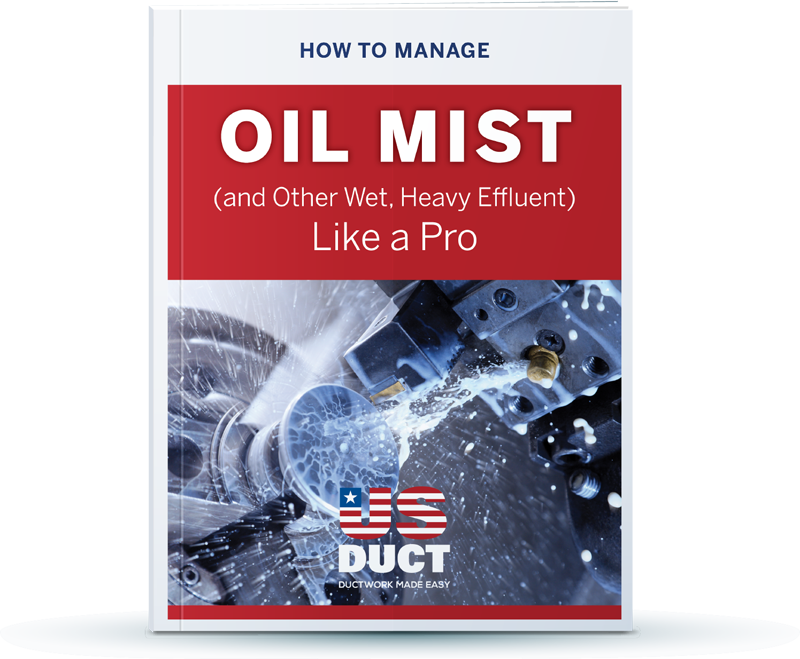The casual observer would consider the vast majority of dust collection systems "leak-free." The systems contain most of the debris conveyed through them, and almost all particulate filtered through can be removed. When dealing with dust or dry nuance particles, whether or not the system is genuinely airtight or liquid-tight isn't usually an issue.
When are most, almost, and usually not good enough?
When moist, toxic, or caustic materials are collected, the tolerance for a less than sealed system vanishes. But the truth is that even modern collection systems that are specifically designed to handle moist, wet, or toxic debris will inevitably leak.
1. The hose to ductwork connection can never be tight enough (trust us on this one)
 In a wet system, leaks between the flex hose and ducting are unavoidable. The final connection between the machining center and ductwork often needs to be joined with flex hose due to unusual pick-up placement or overhead constraint. The hose’s flexibility makes the connection possible; however, the flex hose and hose clamp will always leak — and no amount of adjusting or tightening will prevent it.
In a wet system, leaks between the flex hose and ducting are unavoidable. The final connection between the machining center and ductwork often needs to be joined with flex hose due to unusual pick-up placement or overhead constraint. The hose’s flexibility makes the connection possible; however, the flex hose and hose clamp will always leak — and no amount of adjusting or tightening will prevent it.
What to do about the leaky flex hose to ductwork connection
Oil mist curbs, commonly called drip curbs, are designed to help manage these inevitable leaks by capturing the dripping oil. A welded trough around the curb contains all escaping oil, and ⅛-inch holes slowly redirect the oil back into the machining system.
2. Effluent pools when the system is off or becomes overloaded
Leakage at connection points occurs when effluent pools inside the ducting or overloads the collector’s filtration medium. Pooling can happen when the system's cubic feet per minute (CFM) cannot adequately and continuously move the moisture's weight through it or when the system is turned off, causing any mist that was suspended in the moving air to drop and pool in the bottom of the ducting.
What to do about pooling effluent
 If oil mist is overloading the collector or filter media, adding an in-line oil mist accumulator to the ducting system can reduce the concentration of effluent in the airstream and the likelihood of leaking.
If oil mist is overloading the collector or filter media, adding an in-line oil mist accumulator to the ducting system can reduce the concentration of effluent in the airstream and the likelihood of leaking.
Accumulators are designed to slow the airstream and capture excess effluent on a series of mesh cones. The captured effluent pools within the device where a drain port allows for its reclamation or disposal. The drain port can be connected to a disposal canister or routed back into the machine for reuse, depending on the application. Accumulators can be installed vertically or horizontally and can effectively:
- Reduce leakage during system off time
- Increase filter time
- Save money with less frequent filter maintenance
- Reclaim effluent
3. The ductwork isn’t installed properly
 Correctly installing ductwork means precisely aligning the joints’ angles, tightening connections as much as the method allows, and securely anchoring the system to the ceiling or walls. Even the smallest gaps in ill-fitting and loose connections will leak, and any additional torquing or vibrating will only amplify this problem.
Correctly installing ductwork means precisely aligning the joints’ angles, tightening connections as much as the method allows, and securely anchoring the system to the ceiling or walls. Even the smallest gaps in ill-fitting and loose connections will leak, and any additional torquing or vibrating will only amplify this problem.
How to ensure proper installation
The right mix of duct hangers can adequately secure the system, slowing the impact of everyday wear and tear. Stabilizing-style hangers will reduce movement, and suspension-style hangers will support the system's weight.
Getting your ductwork system airtight and leak-free
Leaks will happen — but it doesn’t mean you can’t control the escaping oil mist or wet effluent and mitigate the damage it can cause. US Tubing is a modular ducting system that uses a v-shaped gasket and torque-tightened clamp to create leak-free connections. When used with special accessories like oil mist curbs and accumulators, US Tubing makes the perfect systems for dealing with high effluent levels.
Contact a Duct Guy to discuss your application.
Topics
Everyone does. But not everyone knows how to handle them.
With the right knowledge and tools, anyone can mitigate the risks associated with leaky ductwork. Our guide takes you through what to consider — from common causes to the most secure connections — for effectively managing leaks and maintaining safe, healthy work environments.
